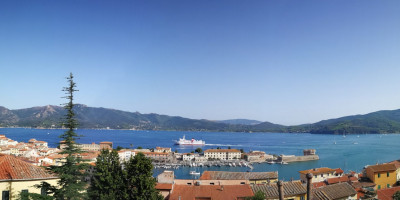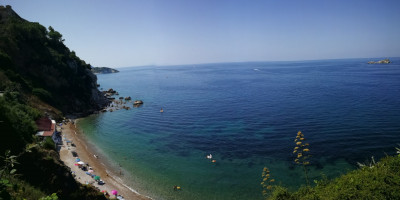Portoferraio a Piedi
Secondo Apollonio Rodio, il luogo dove sbarcarono gli Argonauti di Giasone, poiché stavano cercando Circe, si chiamava Porto Argo (Argòos limèn, Ἀργῳος λιμὴν; da argòs, «bianco», in riferimento alle locali scogliere e spiagge di aplite tormalinifera biancastra) ed è oggi localizzato presso la spiaggia delle Ghiaie. Nell’area si trovano i resti di due ville marittime romane (villa delle Grotte e villa della Linguella) che testimoniano un’assidua frequentazione in età imperiale. Secondo una tradizione letteraria del XVIII secolo, peraltro non attestata da alcun riferimento storico e documentale, in età romana il sito si sarebbe chiamato Fabricia – da cui Borghi Fabbricii – in riferimento alle antiche lavorazioni siderurgiche presenti nella zona. Già dal XVIII secolo furono rinvenute tracce di un insediamento romano presso l’attuale centro storico di Portoferraio; murature in opus reticulatum e opus sectile, lastre di piombo, denarii e tracce di almeno due piccole necropoli collocate presso i Mulini e gli Altesi.
Il toponimo Ferraia o Ferraria è documentato a partire dal 1278 e trae origine dalle attività siderurgiche presenti nell’area sin da epoca etrusco-romana. Il circondario di Ferraia (il cui comune è documentato dal 1289) fu pesantemente colpito nel 1544 dalla flotta di Khayr al-Din Barbarossa, con la distruzione del vicino fortilizio di Montemarsale e della pieve medievale dei Santi Giovanni e Silvestro. Successivamente, il distretto di Ferraia fu ceduto dagli Appiano per ordine dell’imperatore Carlo V ai Medici nel 1547. In cartografie del XVI secolo si registra una mutazione del nome in Ferraio
Portoferraio fu rifondata per volere di Cosimo I granduca di Toscana nel 1548, affidando all’architetto Giovanni Camerini la progettazione di una città fortificata simbolicamente chiamata Cosmopoli (“città di Cosimo”) concepita come presidio militare con lo scopo di difendere le coste toscane nonché come sede dei Cavalieri di Santo Stefano e che nel 1583 venne così descritta da Giovan Battista Adriani: «Il poggio più elevato, che signoreggia e scuopre tutto il porto, fu chiamato il Falcone: l’altro men rilevato dalla forma della fortezza secondo la qualità del sito hebbe nome la Stella, spargendo le sue fortificazioni qua e là a guisa di razzi. Parimente fermarono un bastione sopra la bocca del porto, il quale fu chiamato dalla forma Linguella.» L’epigrafe marmorea che il granduca fece apporre sulla cosiddetta Porta a Mare, l’ingresso principale del porto, descrive infatti la fondazione della nuova città: «Templa, moenia, domus, arces, portum Cosmus florentinorum dux a fundamentis erexit a. D. MDXXXXVIII».
La prima fotografia scattata all’isola d’Elba (1855 circa), raffigurante la gendarmeria del granduca Leopoldo II a Portoferraio
La città, exclave toscana nel Principato di Piombino, all’inizio era poco più che un insieme di fortificazioni (ancora tutt’oggi visitabili e ben conservate), come i tre forti: Forte Stella, Forte Falcone e la Linguella (mentre Forte Inglese fu realizzato successivamente per rinforzare la cittadina in vista dell’assedio della flotta britannica) e la bellissima cinta muraria, i cui resti, tuttora in buono stato e resi abitabili, circondano il centro storico di Portoferraio. Ancora oggi è in gran parte visibile l’imponente cortina di bastioni che dalla rada si eleva fino al Forte del Falcone (Bastione della Cornacchia a difesa dell’antica Porta a Terra, Bastione delle Palle di sotto che dalla Porta degli Altesi dava accesso al superiore Bastione delle Palle di sopra, Cortina degli Altesi, Bastione del Veneziano, Opera del Raggione, Opera del Cavaliere, Tanaglia sotto il Falcone, Opera nuova, Opera di Santa Fine, Batteria degli Spagnoli di fronte alla spiaggia delle Ghiaie). Nel 1694, ad opera del governatore Mario Tornaquinci, fu realizzato il cosiddetto Ponticello, una struttura – poi demolita nel gennaio 1925 – sul fossato artificiale che separava la città fortificata dal resto dell’isola. Nell’anno 1700 furono lastricate le vie del centro storico, per volere del governatore Benedetto Guerrini, con bozze irregolari di calcare compatto rosato estratto nelle cave marittime di Punta Pina e Punta degli Scalpellini, i due promontori che chiudono la vicina insenatura di Bagnaia. Tale caratteristica, nel passato, ha suggerito l’epiteto di «Città rosa» dato a Portoferraio
La città rimase sotto il controllo del Granducato di Toscana fino al XVIII secolo quando l’isola, per la sua posizione strategica, fu al centro di una guerra tra Francia, Austria e Inghilterra. Con un decreto del 1702, il governatore Alessandro Del Nero istituì la realizzazione di un ghetto presso il Forte Stella, nella strada che poi prese il nome di via degli Ebrei. Nell’aprile 1814, con il Trattato di Fontainebleau, l’isola fu affidata a Napoleone Bonaparte come sede del suo primo esilio. Napoleone scelse Portoferraio come capoluogo dell’isola; nella città sono ancora presenti e visitabili le due ville che furono sua residenza, quella di San Martino e la Villa dei Mulini. Fu grazie al regno dell’imperatore francese, seppur breve (1814-1815), che Portoferraio crebbe in importanza e modernità in maniera esponenziale, come tutta l’isola del resto, grazie alle infrastrutture create e alla valorizzazione delle miniere di ferro di Rio Marina. In questo periodo Portoferraio divenne il porto adibito al trasporto del ferro dalle miniere elbane al continente, e da ciò deriva il nome attuale.
[Fonte: Wikipedia]





